
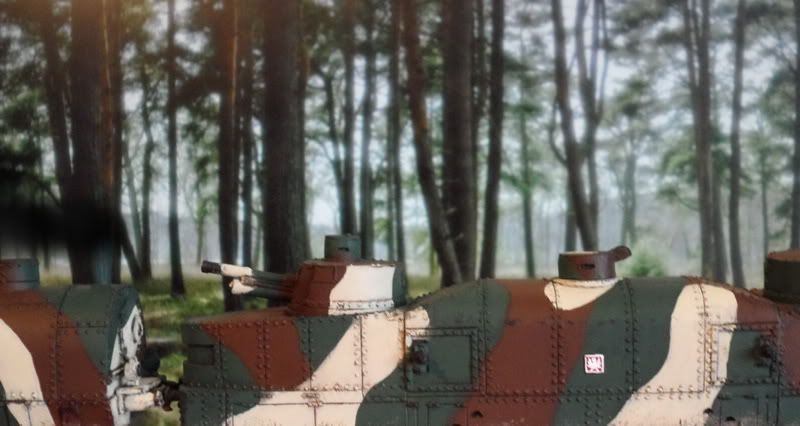
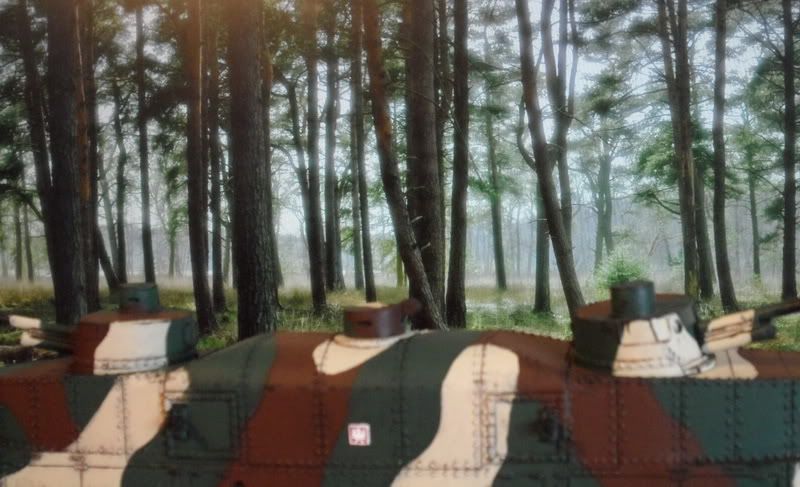
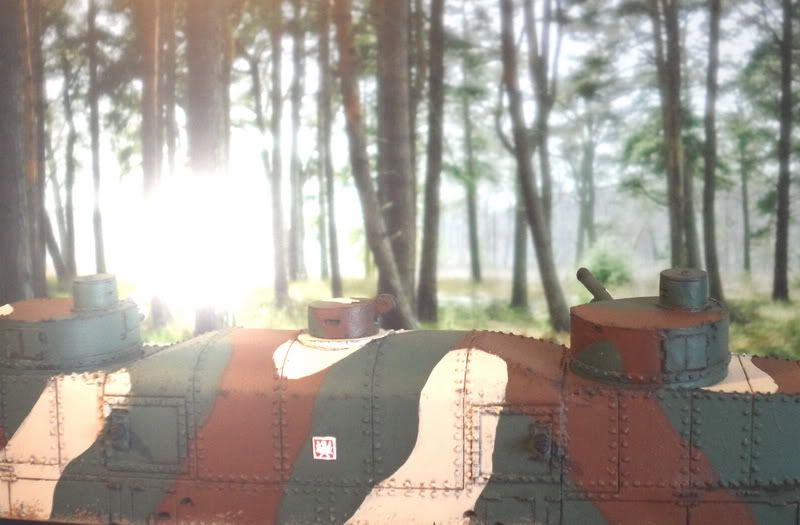

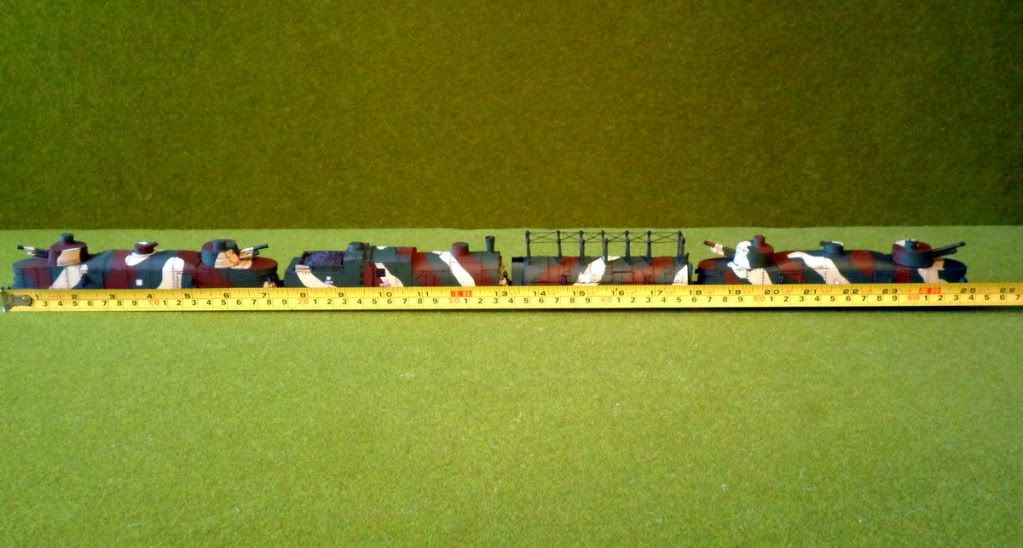
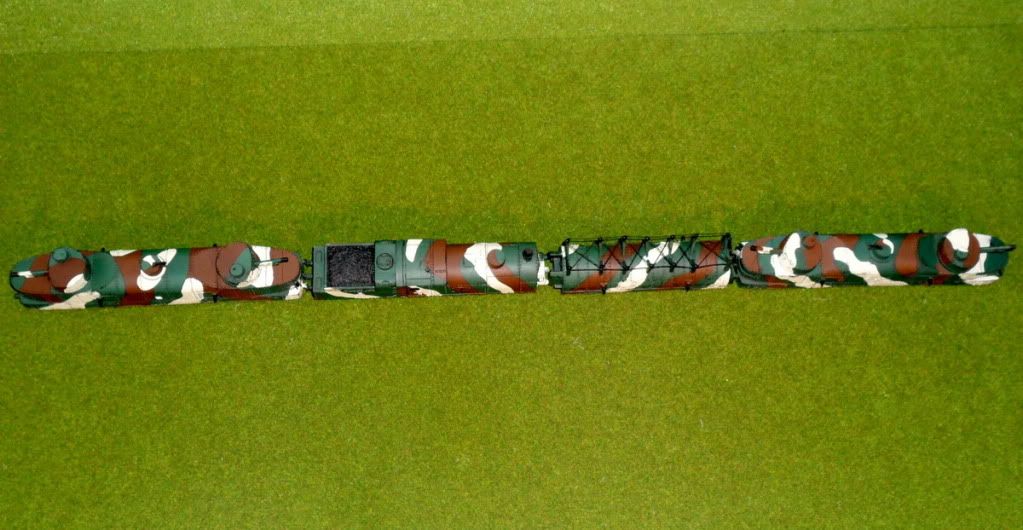 Got around to finish this model today, absolutely crazy model which makes me grin when I look at it. As I mentioned earlier the train is 25" long . It was a bit daunting to look at all the resin and metal pieces the day I opened the box, but the assembly was painless and painting was not as big a problem as I thought it would be. I did use my GW spray gun to undercoat the entire train "Orkhide shade" and even roughly marked the camo pattern using dark brown and bone white - but I painted the entire train by hand after that.
Got around to finish this model today, absolutely crazy model which makes me grin when I look at it. As I mentioned earlier the train is 25" long . It was a bit daunting to look at all the resin and metal pieces the day I opened the box, but the assembly was painless and painting was not as big a problem as I thought it would be. I did use my GW spray gun to undercoat the entire train "Orkhide shade" and even roughly marked the camo pattern using dark brown and bone white - but I painted the entire train by hand after that.A fair bit of information about the Polish armored trains (some of this was touched upon in the FoW:Blitzkrieg book but it might be interesting to get a more detailed description).
Poland had 10 trains, divided into two groups, with trains numbering 51-55 in the northern sector and trains numbering 11-15 in the Southern sector.
Nr. 11 "Danuta"
Nr. 12 "Poznańczyk"
Nr. 13 "Generał Sosnkowski"
Nr. 14 "Paderewski"
Nr. 15 "Śmierć" (Light armored train)
Nr. 51 "Pierwszy Marszałek"
Nr. 52 "Piłsudczyk"
Nr. 53 "Śmiały"
Nr. 54 "Groźny"
Nr. 55 "Bartosz Głowacki" (Light armored train)
Serving in the defense of Poland there were also a few improvised armored trains.
2 trains used for training
2 improvised trains serving the Warsaw defense
2 improvised trains serving the coastal defense
 The crew of each such armored train numbered somewhere around 120 men.
The crew of each such armored train numbered somewhere around 120 men. All such trains also had an auxiliary train or "quartermasters section". These trains had a kitchen, workshop, ambulance coach, water and coal supplies and two trucks and a couple of motorcycles for repair patrols. These auxiliary trains were unarmored and their total length was somewhere around 250meters.
Ti3 Locomotives
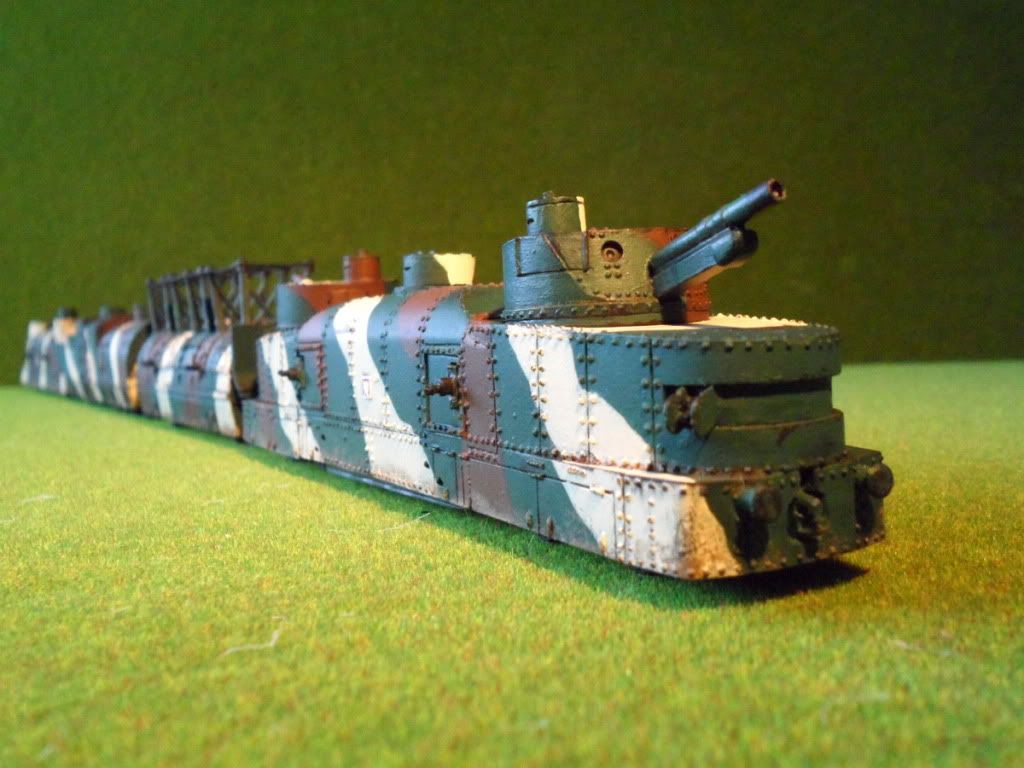
In 1918-24 period Poland used more than 100 armored trains, which used a variety of armored locomotives. After the war with Soviet Russia had ended in 1921, it was decided to keep only
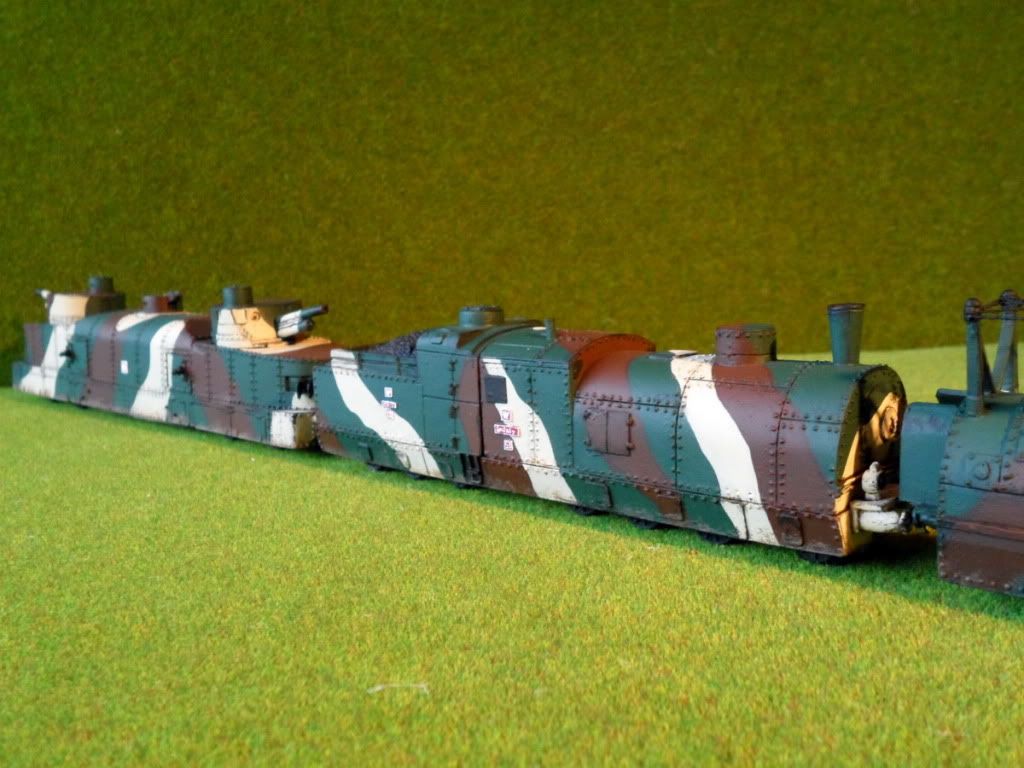 12 most modern armored trains, and in the following few years most of the trains were decomposed. Then, it became possible to replace all the locomotives used with only one type. The advantages of such a standardization were obvious, like the simpler armoring with similar sets of armored plates, an easier maintenance and crew training. That's why in 1926 a locomotive of the former Prussian series G53, given the series designation Ti3 in Poland after 1923, was chosen as the standard one for armored trains.
12 most modern armored trains, and in the following few years most of the trains were decomposed. Then, it became possible to replace all the locomotives used with only one type. The advantages of such a standardization were obvious, like the simpler armoring with similar sets of armored plates, an easier maintenance and crew training. That's why in 1926 a locomotive of the former Prussian series G53, given the series designation Ti3 in Poland after 1923, was chosen as the standard one for armored trains.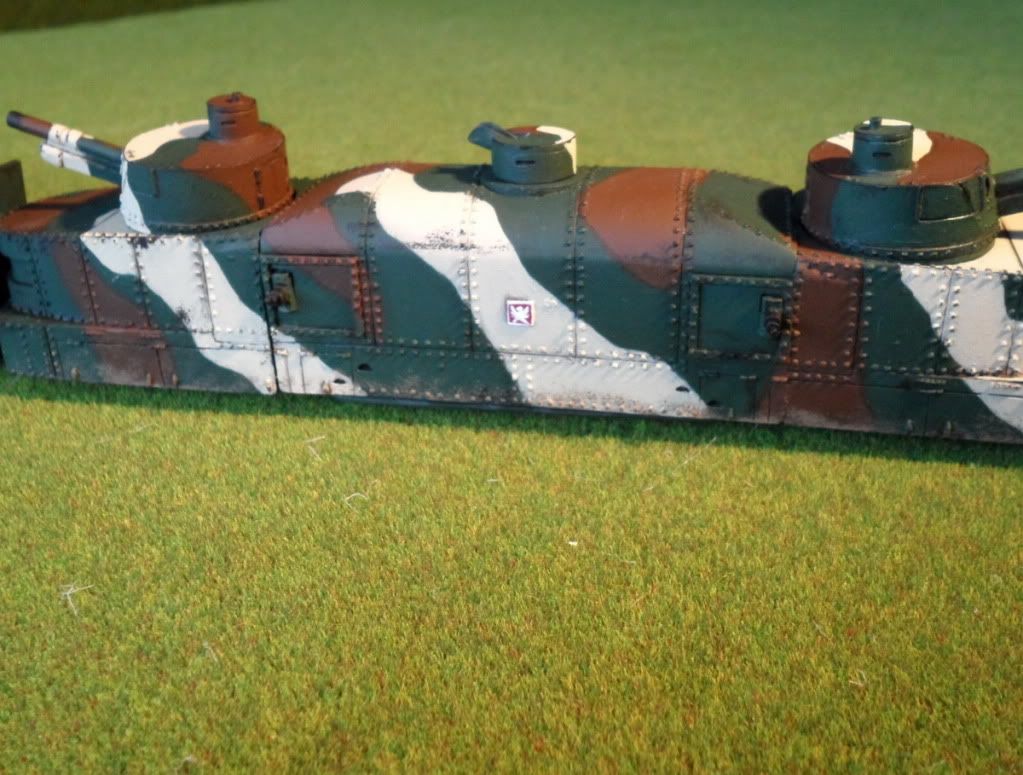 After the First World War, Poland received 16 locomotives of Prussian series G53 as war reparations. Just in 1918 five of them were given to the Army. At least two were armored in 1920 in the Main Workshops of Warsaw-Praga depot (G53-4021 and G53-4024(?)) - they were used in armored trains "Msciciel" (later in "Danuta") and "General Sosnkowski". The locomotives had a rational armor design, basing upon earlier combat experience. It certainly incorporated also some features taken from Russian armored locomotives series "O", like the commander's turret above the tender.
After the First World War, Poland received 16 locomotives of Prussian series G53 as war reparations. Just in 1918 five of them were given to the Army. At least two were armored in 1920 in the Main Workshops of Warsaw-Praga depot (G53-4021 and G53-4024(?)) - they were used in armored trains "Msciciel" (later in "Danuta") and "General Sosnkowski". The locomotives had a rational armor design, basing upon earlier combat experience. It certainly incorporated also some features taken from Russian armored locomotives series "O", like the commander's turret above the tender.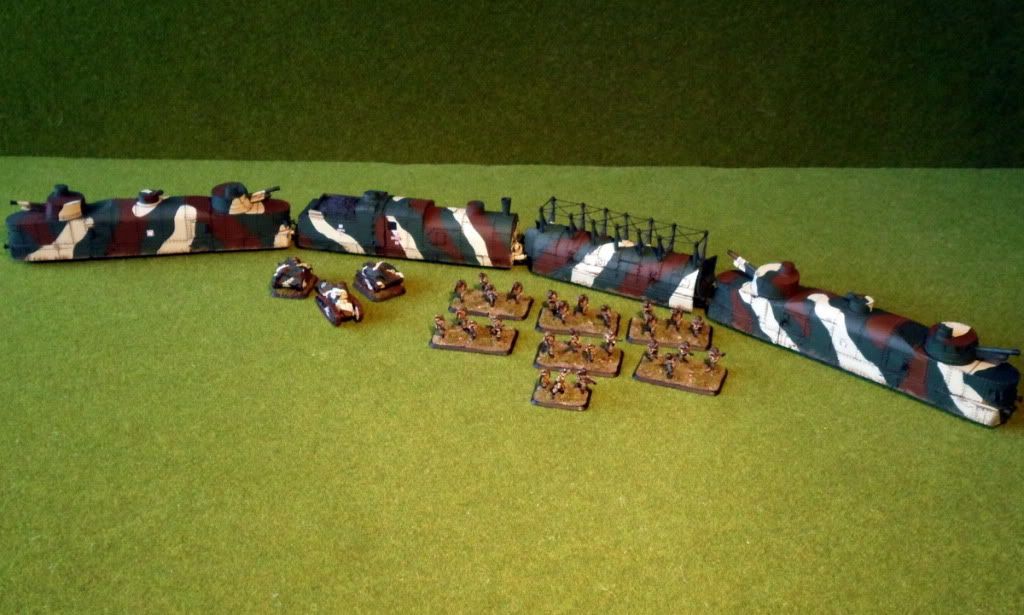 The new design accepted in 1926 copied the already existing one, with only minor changes, like taller command compartment and a new command turret. On 20 November 1926 the Ministry
The new design accepted in 1926 copied the already existing one, with only minor changes, like taller command compartment and a new command turret. On 20 November 1926 the Ministry  of War ordered to start the locomotive exchange in existing trains. The existing locomotives were to be disarmed and given to a civilian service, while the locomotives Ti3 were undergoing the main repair and armoring in the Main Workshops of Warsaw-Praga depot. The whole process was slow, however, because most of Polish 12 armored trains were preserved in a reserve. The first locomotives Ti3 were armored in 1927 and until 1932 all twelve were armored. The remaining four were in the civilian service in Warsaw (at Army's disposal, however).
of War ordered to start the locomotive exchange in existing trains. The existing locomotives were to be disarmed and given to a civilian service, while the locomotives Ti3 were undergoing the main repair and armoring in the Main Workshops of Warsaw-Praga depot. The whole process was slow, however, because most of Polish 12 armored trains were preserved in a reserve. The first locomotives Ti3 were armored in 1927 and until 1932 all twelve were armored. The remaining four were in the civilian service in Warsaw (at Army's disposal, however). The Ti3 armored locomotive, old camouflage scheme. Ten armored locomotives series Ti3 were used in 1939 in combat in Polish regular armored trains. Most likely further two were used in Polish training armored trains, "Zagończyk" and "Stefan
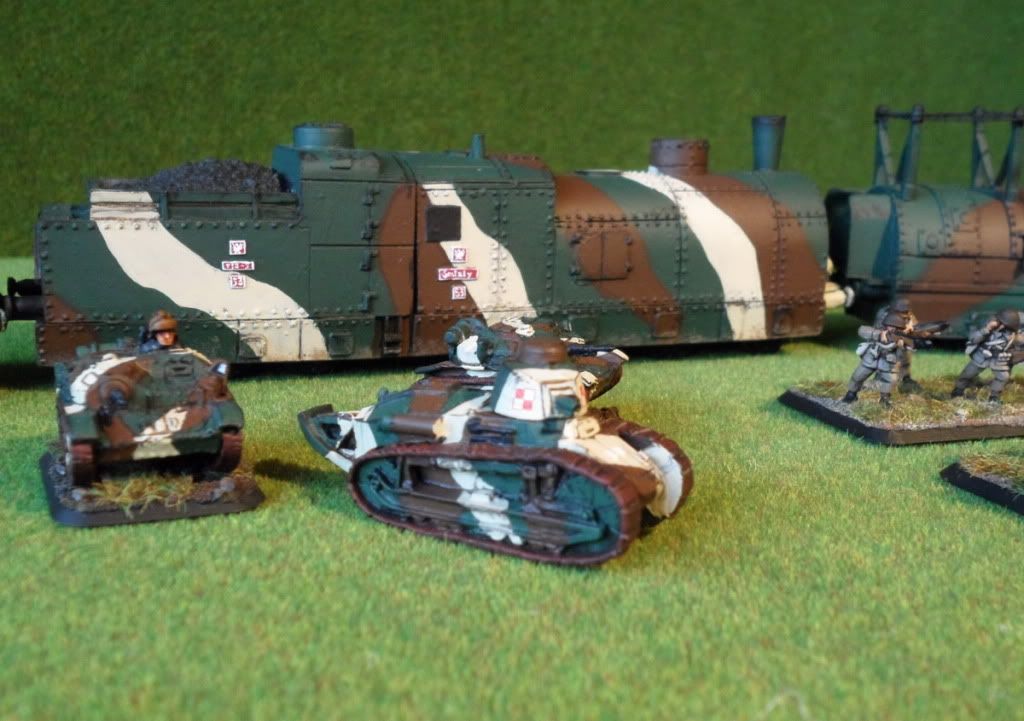 Czarniecki", which also took part in combat. Some of the locomotives survived the September 1939 and were captured and put into the German or Soviet service (those in Soviet service were captured by the Germans two years later, anyway).
Czarniecki", which also took part in combat. Some of the locomotives survived the September 1939 and were captured and put into the German or Soviet service (those in Soviet service were captured by the Germans two years later, anyway).The locomotive and the tender were fully armored - the armor thickness was 8 - 20mm, its weight was about 13t. It protected
 against machine gun bullets and splinters. The armor plates were fixed with rivets and screws to the framework - there was a space between the armor and the locomotive body.
against machine gun bullets and splinters. The armor plates were fixed with rivets and screws to the framework - there was a space between the armor and the locomotive body.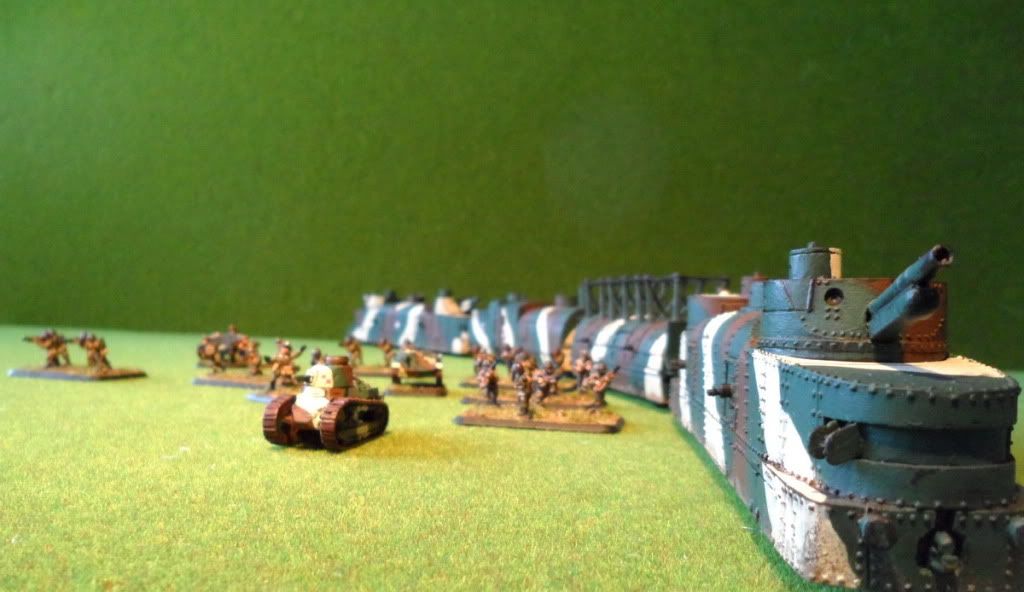 Upon the tender there was a train commander's turret (the entrance was from the driver cab, by the ladder). The crew of the locomotive was three, plus the commander with his assistants. The turret was equipped (in the thirties) with a short-range radio RKB/C to contact the draisines (its aerial was stretched on the masts upon the tender) and an intercom to contact the wagons. It also had some optical and sonic means of internal communication (color lights, bells and horns). Upon the turret there was an observation cupola, with a hatch on the roof.
Upon the tender there was a train commander's turret (the entrance was from the driver cab, by the ladder). The crew of the locomotive was three, plus the commander with his assistants. The turret was equipped (in the thirties) with a short-range radio RKB/C to contact the draisines (its aerial was stretched on the masts upon the tender) and an intercom to contact the wagons. It also had some optical and sonic means of internal communication (color lights, bells and horns). Upon the turret there was an observation cupola, with a hatch on the roof. Assault car
 The assault car was intended for the transportation of an assault platoon. In 1939 the same wagons were used in trains nr. 53 (Śmiały), nr. 55 (Bartosz Głowacki) and nr. 12 (Poznańczyk). They differed in a bottom armor skirt (on "Bartosz Głowacki" - cut off, only the wheels covered, in "Śmiały" - full skirt, in "Poznańczyk" - partially cut-off). Moreover, this wagon has centrally placed doors.
The assault car was intended for the transportation of an assault platoon. In 1939 the same wagons were used in trains nr. 53 (Śmiały), nr. 55 (Bartosz Głowacki) and nr. 12 (Poznańczyk). They differed in a bottom armor skirt (on "Bartosz Głowacki" - cut off, only the wheels covered, in "Śmiały" - full skirt, in "Poznańczyk" - partially cut-off). Moreover, this wagon has centrally placed doors.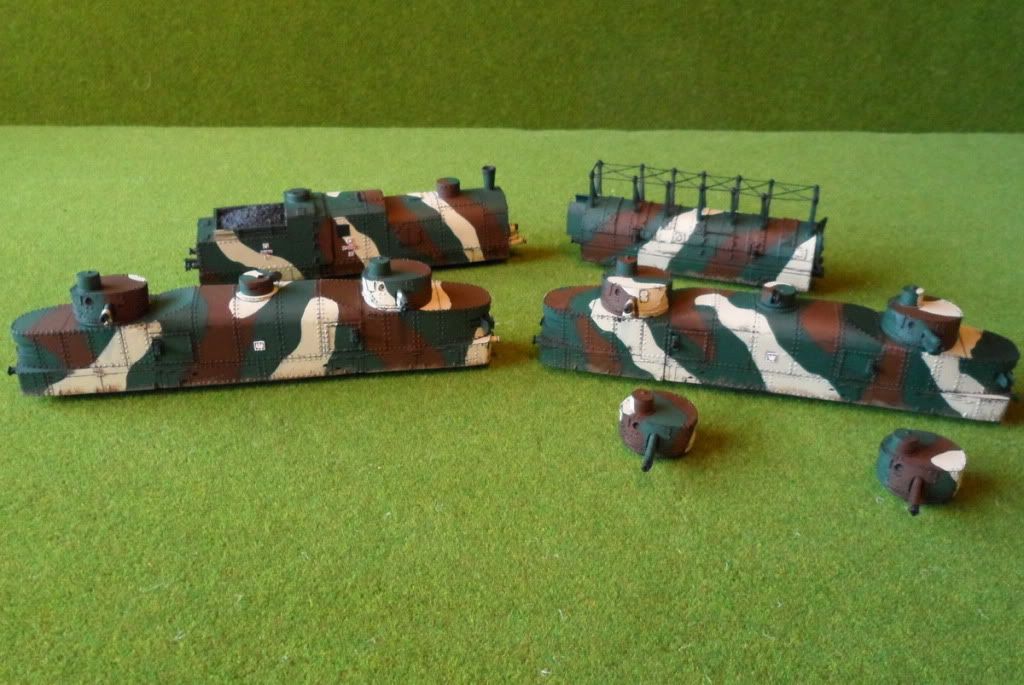 The origin of this wagon was the same, as of artillery wagons (Polish-built in Warsaw upon ex-Soviet flatcar). The wagon had a two-leaf door in each side, and also doors in both end walls. It was armed with four 7.92mm wz. 08 MG's in the sides, the ammunition was 3,750 rounds per MG. The armor was the same as in artillery wagons. The assault platoon consisted of 32 men (1 officer, 7 NCO's, 24 soldiers, with 2 LMG's). The total wagon's crew was about 40 (with signalmen and stretcher-bearers).
The origin of this wagon was the same, as of artillery wagons (Polish-built in Warsaw upon ex-Soviet flatcar). The wagon had a two-leaf door in each side, and also doors in both end walls. It was armed with four 7.92mm wz. 08 MG's in the sides, the ammunition was 3,750 rounds per MG. The armor was the same as in artillery wagons. The assault platoon consisted of 32 men (1 officer, 7 NCO's, 24 soldiers, with 2 LMG's). The total wagon's crew was about 40 (with signalmen and stretcher-bearers). Since the early thirties, the assault wagon was equipped with long-range radio RKD/P (range - up to 80km), placed in a separate radio cab in the middle of the wagon. The wagon was also fitted with a power generator, batteries and a large clothes line aerial on the roof (7 masts in two rows - the wagon on the
Since the early thirties, the assault wagon was equipped with long-range radio RKD/P (range - up to 80km), placed in a separate radio cab in the middle of the wagon. The wagon was also fitted with a power generator, batteries and a large clothes line aerial on the roof (7 masts in two rows - the wagon on the  photo has its aerials removed). Apart from the doors, the wagon also should have hatch in the bottom.
photo has its aerials removed). Apart from the doors, the wagon also should have hatch in the bottom.The wagon's length was 11.6 m, width: 3.15 m, height (without
 aerial masts): 4.7 m, axle track: 6.1 m, axle pressure up to 14 t.
aerial masts): 4.7 m, axle track: 6.1 m, axle pressure up to 14 t.Artillery car
 Each wagon was armed (in 1939) with one 100mm wz. 14/19P howitzer in the lower turret (a Czech Skoda gun, also built in Poland) and one 75mm wz. 02/26 field gun in the upper turret (modified in Poland Russian 76.2mm 3in Putilov guns, called "the orthodox" gun in mounted artillery). Their field of fire was 360°. The turrets were essentially the same as in the next 'type III' wagons, but without observation cupolas. The amount of artillery ammunition carried in one wagon was probably 240 rounds.
Each wagon was armed (in 1939) with one 100mm wz. 14/19P howitzer in the lower turret (a Czech Skoda gun, also built in Poland) and one 75mm wz. 02/26 field gun in the upper turret (modified in Poland Russian 76.2mm 3in Putilov guns, called "the orthodox" gun in mounted artillery). Their field of fire was 360°. The turrets were essentially the same as in the next 'type III' wagons, but without observation cupolas. The amount of artillery ammunition carried in one wagon was probably 240 rounds. The 100mm wz. 14/19P howitzer details were: maximum range - 9,800 m; shell weight - 12-16 kg; barrel length - L/24; maximum rate of fire - 8 rds/min; crew - 7; maximum elevation - 48°.
The 100mm wz. 14/19P howitzer details were: maximum range - 9,800 m; shell weight - 12-16 kg; barrel length - L/24; maximum rate of fire - 8 rds/min; crew - 7; maximum elevation - 48°.The 75mm wz. 02/26 gun details were: maximum range - 10,700 m; shell weight - 5.3-8 kg; barrel length - L/30; maximum rate of fire - 10 rds/min; crew - 6 or 7; maximum elevation - 11°.
Other armament consisted of 8 x 7.92mm wz. 08 (Maxim) machine guns in wagon's sides and ends. In the early thirties, one 7.92mm wz. 08 anti-aircraft machine gun was added with a small turret on the roof (its maximum elevation was 90°). The ammunition was 3,750 rounds per MG (in 250-round belts).
The armor was made of double layered armor plates. The thickness varied from 12mm to 25mm (the floor was 5 - 8mm). The inside walls of the wagons were probably covered with oak planks. The wagon had one entrance with a two-leaf door on each side. It also had two hatches in both ends, which enabled the crew to pass from one wagon to another (in practice only between one artillery wagon and the assault wagon) - the open doors provided protection from enemy fire.
The wagon's length was 17.20 m (677 in), height - about 4.1 m (161 in). The bogie wheelbase was about 2 m (79 in) and the distance between the inner axles was about 8 m (314 in). The total weight was about 50 t, and the crew - about 35.
Draisines
Col. T. Kossakowski from Engineer Department came up with an idea to adapt old tank Renault FT-17 to an armored draisine role, by mounting it upon a special rail chassis. The main advantage of this revolutionary idea was, that the tank was driving the whole rail unit, and was still able to ride off of its rail chassis, and be used on the ground. The first prototype, built in 1932, was not entirely successful. The draisine wheels were driven by the tank's tracks, through special rollers and transmission. It could achieve a noteworthy speed of 38 km/h (23.6 mph), however.
In the next prototype of 1933, the wheels were driven directly by the tank's engine, using a special drive shaft. During trials, it exceeded a speed of 45 km/h (28 mph), almost unbelievable for FT-17 tank (no doubt, that the FT-17 tank never suspected, that it would ever run so quick). This prototype was accepted, and in January 1938 the first series of 18 rail chassises, manufactured in Chrzanów, were given to both Armored Trains Units. In fact, it was probably the best usage of obsolete, extremely slow FT-17 tanks, and a cheap way of obtaining armored draisines. Until 1939 there were 38 rail chassises produced. Each armored train mobilized in 1939 (apart from nr.15) had two such vehicles.
The light tank Renault FT-17 on the rail chassis was designated: medium rail-and-ground armored draisine R ("R" for Renault). The tank could ride on rails as a rail vehicle, or leave the rail chassis on a track and operate as a regular tank. The FT-17 tanks used as a draisines were modified by fitting a special drive shaft, coming from a gearbox. After the tank rode onto the rail chassis, the crew was connecting the drive shaft to the chassis' drive gear. A whole operation of mounting the tank on rails was taking up to about 3 minutes. Dismounting the tank and riding off of the rail chassis was taking less than 3 minutes.
A rear axle of chassis was driven by the tank's engine. Top speed on rails was 45 km/h, in late series even 55-57 km/h (28 / 34-35 mph). The chassis had a reverse mechanism in its driving gear, so the draisine could ride backwards with the same speed. Thanks to buffers and coupling in front of the chassis, it could also tow some wagon.
Camouflage painting
Since about 1936, Polish armored trains were painted in a standard three-color camouflage for armored vehicles, consisting of irregular sprayed grey-sand, dark brown and brown-green patches. The base color was brown-green.
Before 1936 the older scheme was used: the patches of light yellow-sand, dark brown and dark green were separated with black stripes. In the twenties also some other schemes were used, e.g. four-color pattern with sharp patches of light grey, dark grey , green and brown; or grey only scheme.
..............
Source for the above is this excellent site right here which I also used to some extent when writing my September Campaign PDF: http://derela.republika.pl/armcarpl.htm
No comments:
Post a Comment